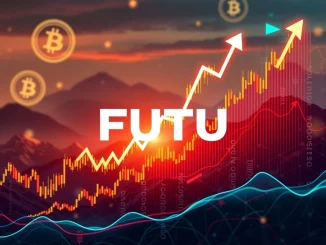
Hey crypto enthusiasts! Ever wonder what the big players are doing behind the scenes? Well, a recent report from Whale Alert just caught our eye, highlighting a significant **USDT transfer**. We’re talking about a massive movement of digital assets that could signal interesting shifts in the market.
What Was This **Large Crypto Transfer** All About?
According to the blockchain tracking service Whale Alert, a colossal amount of Tether (USDT) was on the move. Specifically, 350,000,000 USDT was transferred from a wallet associated with Aave, a major decentralized finance (DeFi) protocol, to the HTX cryptocurrency exchange. Valued at approximately $350 million, this is the kind of transaction that gets the crypto community talking.
Let’s break down the key players involved:
- **USDT:** Tether, the largest stablecoin by market capitalization, pegged roughly 1:1 with the US dollar. It’s often used by traders to move value quickly between exchanges or protocols without converting to fiat.
- **Aave:** A leading DeFi lending and borrowing protocol. Users can deposit crypto to earn interest or borrow assets against collateral.
- **HTX:** Formerly known as Huobi, it’s a major centralized cryptocurrency exchange offering trading, derivatives, and other services.
So, we have a substantial amount of stablecoins moving from a DeFi lending platform to a centralized trading hub. Why does this matter?
Understanding the **Crypto Whale** Phenomenon
In the world of cryptocurrency, a “whale” is an individual or entity holding a very large amount of a particular digital asset. Their movements are closely watched because a single whale’s actions can potentially influence market dynamics, especially for less liquid assets. A **crypto whale** moving $350 million in USDT is definitely worth paying attention to.
Whale Alert’s reports act like a peek behind the curtain, showing us when these large holders are repositioning their assets. While we can’t know the exact intentions behind every **large crypto transfer**, we can analyze the potential reasons and implications based on where the funds are coming from and where they are going.
Why the **Aave Transfer** to HTX?
Moving such a large sum of USDT from a DeFi protocol like Aave to a centralized exchange like HTX could indicate several things. Here are a few possibilities:
- **Preparing to Sell:** The most common assumption when large amounts of stablecoins move to an exchange is that the holder intends to sell other cryptocurrencies (like Bitcoin or Ethereum) for USDT, or potentially sell the USDT for fiat, although the latter is less likely from a major exchange. This could signal potential selling pressure on other assets.
- **Seeking Trading Opportunities:** The whale might be moving funds to HTX to take advantage of specific trading pairs, derivatives markets, or arbitrage opportunities available on that platform. HTX offers deep liquidity for various assets.
- **Consolidating Funds:** The whale might be consolidating funds from various DeFi positions (like earning yield on Aave) into a single exchange account for easier management or deployment elsewhere.
- **Yield Farming or Staking on HTX:** While Aave is a yield platform, HTX also offers various yield products, staking, or participation in exchange-specific events that might offer attractive returns for large holders.
Without more information, it’s difficult to pinpoint the exact reason, but the shift from a decentralized lending protocol to a centralized trading venue is a key observation.
What Could This **HTX Exchange** Inflow Signal?
An inflow of 350 million USDT into any exchange, including the **HTX exchange**, significantly increases the available stablecoin liquidity on that platform. This liquidity can be used for various purposes:
- **Increased Buying Power:** The USDT could be used to buy up other cryptocurrencies listed on HTX, potentially leading to upward price pressure if buying commences.
- **Increased Selling Pressure:** Conversely, it could be the result of selling other assets on HTX, with the whale moving the resulting USDT off the exchange (though in this case, the USDT arrived *at* HTX). Or, it could be preparation to sell *into* a market downturn, accumulating stablecoins beforehand.
- **Market Maker Activity:** Large amounts of stablecoins are crucial for market makers to provide liquidity and facilitate trading pairs. This inflow could support increased trading volume on HTX.
Monitoring the flow of assets to and from exchanges is a fundamental part of on-chain analysis for many traders and analysts trying to gauge market sentiment and potential future price movements.
Staying Informed on **USDT Transfer** and Whale Movements
For everyday crypto participants, tracking large movements like this **USDT transfer** from Aave to HTX serves as a reminder of the significant capital controlled by whales. While one transfer doesn’t dictate the entire market, understanding potential whale behavior can provide valuable context.
Here are some actionable insights:
- **Monitor Whale Alert and Similar Services:** Keep an eye on reports of large transfers to and from exchanges or major protocols.
- **Analyze the Context:** Consider the source and destination. Is it moving from DeFi to CEX? CEX to cold storage? Exchange to exchange? Each move can suggest different intentions.
- **Don’t Panic or Blindly Follow:** Whale movements are just one data point. They don’t guarantee a specific market outcome. Conduct your own research and analysis.
- **Focus on Fundamentals:** While on-chain data is useful, remember that project fundamentals, adoption, regulatory news, and macroeconomics also play huge roles.
This **large crypto transfer** is a prime example of the kind of on-chain activity that analysts track. It highlights the dynamic nature of the crypto market and the significant influence that large holders can potentially wield.
Compelling Summary
In conclusion, the reported **USDT transfer** of $350 million from Aave to HTX is a notable event signaling significant **crypto whale** activity. Moving funds from a DeFi protocol to a centralized exchange could indicate preparation for trading, selling, or strategic repositioning on the **HTX exchange**. While the exact motive behind this **Aave transfer** remains unknown, such a **large crypto transfer** provides valuable data for those monitoring the market. It underscores the importance of on-chain analysis in understanding potential shifts driven by major players. As always, use this information as part of a broader research strategy, and remember that correlation doesn’t equal causation in the volatile world of crypto.



